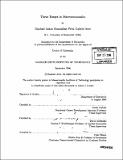Three essays in macroeconomics
Author(s)
Auer, Raphael Anton Maximilian Peter Gabriel
DownloadFull printable version (8.198Mb)
Alternative title
3 essays in macroeconomics
Other Contributors
Massachusetts Institute of Technology. Dept. of Economics.
Advisor
Xavier Gabaix and Daron Acemoglu.
Terms of use
Metadata
Show full item recordAbstract
This thesis is a collection of three essays on international trade and economic growth. Chapter 1 analyzes the dynamic gains from trade in a Hecksher-Ohlin economy with endogenous factor accumulation. In a framework where heterogeneous workers make educational decisions in the presence of complete markets, I first show how convergence of factor rewards induces divergence of factor abundance and levels of income. When heterogeneous workers invest in schooling, higher type agents earn a surplus from their investment. By affecting educational decisions, trade influences the international distribution of this surplus. The latter effect tends to benefit richer countries disproportionately, leading to divergence of welfare when markets are opened to trade. The shift of investments to initially rich countries also leads to a global increase of the average skill premium despite a decrease of the price of skill intensive goods. I next examine whether the factor content of trade indeed does affect domestic education decisions. To establish a causal relation, I instrument for the factors embodied in actual imports by the geographic component of trade. The constructed measures of geographical proximity to skilled and unskilled labor have significant effects on domestic educational decisions. (cont.) Countries that tend to be close to international supply of skilled labor have lower levels of advanced education, while the reverse is true for countries that are close to labor abundant nations. A one standard deviation difference in geographic proximity to skilled labor is associated with a difference' of about 2/3 of a year of average higher education. Chapter 2 examines why movements of relative costs brought about by exchange rate fluctuations are passed on to customers only slowly, and never to a full extent. We first develop a perfectly competitive economy featuring heterogeneity of both good qualities and of consumer valuations. In equilibrium, high valuation consumers and high quality firms are matched. The relative scarcity of different qualities leads to pricing-to-market and markups that are determined by the local toughness of competition. Our production setup features trade in intermediate goods, local assembly that is subject to decreasing returns and fixed costs of market entry. In every export market, firm entry and size decisions are determined by how local prices compare to the cost of production at home. We next analyze how changes in the real exchange rate are transmitted internationally. (cont.) In the short run, the set of firms active in the export sector is fixed, but each firm accommodates changes in the exchange rate by adjusting the quantity of its exports. Due to this response of export volume to the relative cost of production, market toughness counteracts exchange rate movements, leading to partial pass-through in the short run. Due to the presence of fixed costs of market access, in the long run also the set of firms that are actively exporting reacts to movements of the real exchange rate, with two associated consequences. Firstly, pass-through is larger than in the short run because long run export volume responds to relative costs due to changes in both the average firm size and in the number of firms. Secondly, the response of the market entry decision to changes in the relative cost of production affects only low quality firms, which fetch a relatively low price for their output. Exchange rate movements thus change the composition of actively exporting firms, with the consequence that aggregate price indexes overstate the actual extent of pass-through in the long run. Chapter 3 further examines the seminal work of Acemoglu et al. (2001) on the effects of settler mortality on colonization policies during early imperialism. (cont.) The authors build a strong case for the importance of institutions as the primary force of economic development. However, because their empirical analysis is limited to former colonies, they cannot directly distinguish their theory from the rivaling view that a country's disease environment has direct effects on economic prosperity and institutions. In this paper, using either additional historical sources or a model of the geographic determinants of disease, I first construct two measures of mortality rates including up to 36 countries that have not been colonized. I then show that mortality did affect institutional development in former colonies but not in the rest of the sample. This can only be rationalized in the context of the colonial origins theory of Acemoglu et al. Turning to disentanlge the relation between institutions and income, I sometimes find that disease environment influences income also directly and correspondingly, that institutions are somewhat less important for prosperity in my specifications than when working with a sample composed of only former colonies. Incorporating these findings, I estimate that institutions are the major determinant of long run prosperity and can explain about 50% of the observed variation of current income levels, while the direct effects of disease environment can account for about 15%.
Description
Thesis (Ph. D.)--Massachusetts Institute of Technology, Dept. of Economics, 2006. Includes bibliographical references.
Date issued
2006Department
Massachusetts Institute of Technology. Department of EconomicsPublisher
Massachusetts Institute of Technology
Keywords
Economics.